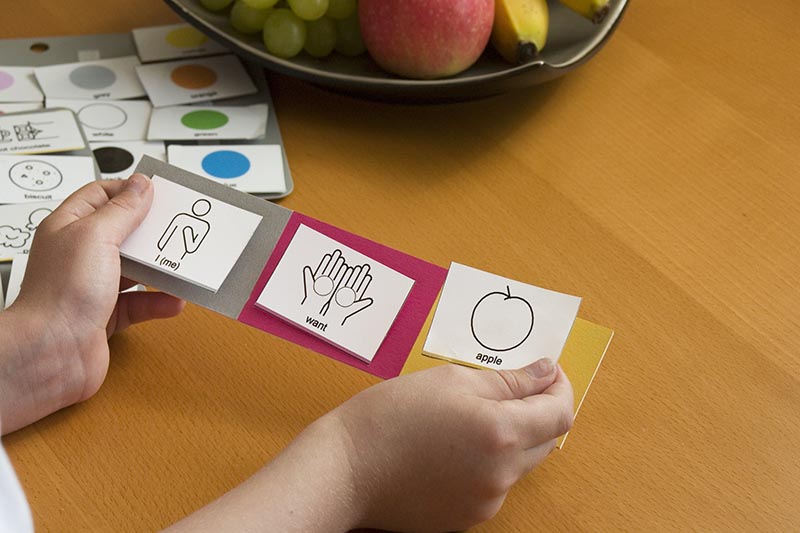Families For Life | Language Development: Children With ASD

Children with autism spectrum disorder (ASD) can have difficulties with language and language development. However, there are things you can do to help your child with ASD learn language.
Language development in children with autism spectrum disorder (ASD)
All children start developing language from the day they’re born. This happens through their relationships and play with other people.
However, it’s harder for children with autism spectrum disorder (ASD) to learn and use language than it is for typically developing children.
This is because children with ASD tend to show less interest in other people in the first 12 months of life. They’re more focused on things going on around them. Asthey don’t need or want to communicate with other people as much as typically developing children do, they don’t get as many chances to develop their language skills.
For example, a three-month-old baby who’s distracted by a ceiling fan is less likely to tune into a smiling and tickling game with her parents. By 9 months, if she still isn’t tuning into her parents, she’s less likely to point at things she wants to share with them. She’s less likely to listen to her parents as they name things around her. This means she misses these chances to build her vocabulary.
Supporting language development for children with ASD
Creating reasons to use language
If your child with autism spectrum disorder (ASD) has a reason to use language, she’s more likely to try.
You can create reasons for your child to use language as part of your everyday activities together. For example, you could put her favourite toy out of reach so she needs to ask for it. You could also take turns opening picture book flaps and talking about or showing each other what you’ve found.
You can gradually make it harder, as your child learns. For example, you could start with your child just saying ‘toy’ when she wants you to give her the toy and moving on to saying ‘toy please’.
Using play
Play is how children learn, including how they learn language. By playing games with your child, or just by making play part of your everyday activities, you can create opportunities for your child to develop language.
For example, if you’re doing a jigsaw with your child, you could hand your child a piece of the puzzle when she asks for it with eye contact. Or if you’re making your child a snack, you could give her a slice of apple after she asks for it.
Modelling language
You can show your child how to respond or ask for something by using modelling. Modelling involves speaking and using facial expressions and gestures in front of your child. It also means giving your child examples of what you want her to learn, at a level that’s right for her.
For example, you could comment on what you’re doing, like saying ‘open’ as you open the car door.
You can also comment on what your child is doing, like saying ‘stuck’ as she tries to open a zipper on a bag.
If your child is trying to say something, you can model the words that you think she needs, like ‘help’ as she holds up a packet of food that she can’t open.
It’s best to use phrases that contain 1-2 more words than your child is currently using in her own speech. For example, if she isn’t yet talking, model 1-2 word sentences. If she’s speaking in 2-3 word sentences, repeat what she says but add a couple more words to show her how to build bigger sentences.
Building your child’s skills
To develop language, your child needs regular, meaningful and motivating opportunities to practise particular language skills.
For example, you could work on a skill like greeting people. Your child could start with greeting you with eye contact when you get home from work. The next step could be eye contact and a cuddle, then eye contact, a cuddle and saying ‘hi’. You could then work on transferring the skill to saying ‘hi’ when Grandma comes to visit.
Rewarding language use
You can reward your child when she listens, understands or expresses herself. This could be a natural consequence like giving your child the next piece of the puzzle when she makes a request, or smiling and making a comment to let her know you’re interested when she shows you a toy.
It doesn’t mean giving your child rewards like sweets or stickers.
Language differences in children with ASD
Children with autism spectrum disorder (ASD) can find it hard to relate to and communicate with other people.
They might be slower to develop language, have no language at all, or have significant problems with understanding or using spoken language. They might not use gestures to make up for the problems they have with words.
Children with ASD tend to communicate mostly to ask for something. They don’t tend to communicate for social reasons, like sharing information.
They also often have difficulty knowing when and how to communicate with people in socially appropriate ways – for example, they might not make eye contact or let another person take a turn in a conversation.
To communicate effectively, children need to:
understand what other people say to them (receptive language)
express themselves using words and gestures (expressive language)
use their receptive and expressive language skills in socially appropriate ways.
© raisingchildren.net.au, translated and adapted with permission
Explore more